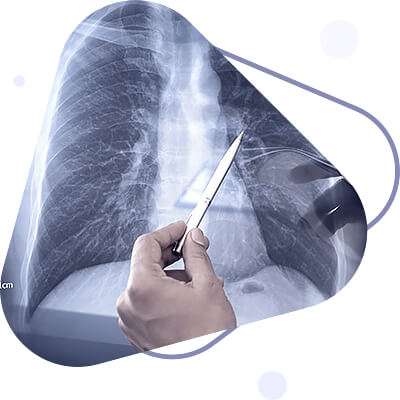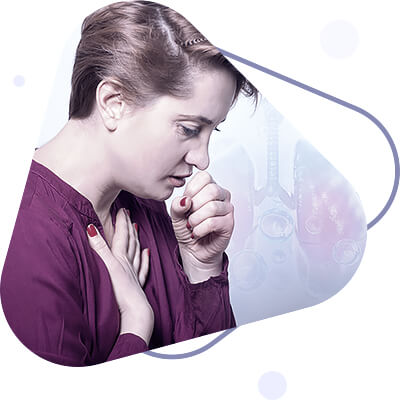Respiratory diseases are characterized by a variety of clinical and morphological manifestations, which is determined by a large number and variety of etiological factors, leading to the development of diseases of these organs, age features, the peculiar structure of the lungs. In the occurrence of respiratory diseases are important biological pathogens, primarily viruses and bacteria that cause inflammatory processes in the bronchi and lungs (bronchitis, tracheitis, bronchiolitis, pneumonia). No less of a role in the occurrence of inflammatory, allergic (bronchial asthma) and tumor (cancer) diseases of the bronchi and lungs play a chemical and physical agents that enter the airways and lungs with polluted air. In the emergence of bronchial and lung disease is a great role of hereditary factors and age characteristics.
However, the occurrence of respiratory diseases is determined not only by pathogenic and the presence of background factors, but also by the state of the protective barriers of the respiratory system, among which there are aerodynamic filtration, humoral and cellular factors of general and local protection. Aerodynamic filtration is mucocellular transport performed by ciliated epithelium of bronchial tree. Humoral factors of local protection of the respiratory system include secretory immunoglobulins (IgA), the complement system, interferon, lactoferrin, protease inhibitors, lysozyme, surfactant, chemotaxis factor, lymphokines, while humoral factors of general protection include IgM and IgG. Cellular factors of local protection of the respiratory system are represented by alveolar macrophages, and general protection by polymorphonuclear leukocytes, adherent macrophages and lymphocytes. Lack of components of protective barriers of the respiratory system can be hereditary (deficiency of one or more factors) or acquired (the result of various external influences).

Modern clinical morphology has many methods of diagnostics of respiratory diseases. Among them cytological and bacterioscopic examination of sputum, bronchoalveolar flushes (bronchoalveolar lavage), biopsy of bronchi and lungs have the greatest value.
Among respiratory diseases, acute bronchitis, acute inflammatory (pneumonia) and destructive (abscess, gangrene) lung diseases, chronic nonspecific lung diseases, pneumoconiosis, bronchial and lung cancer are the most important; among pleural diseases, pleurisy is most common.
Acute bronchitis
Acute bronchitis - acute inflammation of the bronchi - can be an independent disease or a manifestation of a number of diseases, in particular pneumonia, chronic glomerulonephritis with renal failure (uremic acute bronchitis), etc.
Etiology and pathogenesis. Among etiological factors the role of viruses and bacteria causing acute respiratory diseases is great. Of great importance are the effects on the respiratory system of physical (dry or cold air), chemical (inhalation of chlorine vapor, nitrogen oxides, sulfur dioxide, etc.) factors and dust. The pathogenic effect of these factors contributes to hereditary failure of protective barriers of the respiratory system, primarily mucocellular transport and humoral factors of local protection, and damage to mucocellular transport with the development of acute bronchitis is exacerbated. It is connected with the fact, that in response to pathogenic action mucus production by bronchial glands and bocalytic cells increases, and it leads to sloughing of ciliated prismatic epithelium, denudation of bronchial mucosa, penetration of infection into bronchial wall and its further spreading.
Pathological anatomy. In acute bronchitis the bronchial mucosa becomes fulvous and swollen, small hemorrhages and ulcerations are possible. In most cases there is a lot of mucus in the bronchial lumen. The bronchial mucosa develops various forms of catarrh (serous, mucous, purulent, mixed), fibrinous or fibrinous-hemorrhagic inflammation; destruction of the bronchial wall is possible, sometimes with ulceration of the mucosa, in this case we speak about destructive-ulcerative bronchitis. In bronchioles acute inflammation - bronchiolitis - can be productive, which leads to thickening of the wall due to its infiltration by lymphocytes, macrophages, plasma cells, proliferation of epithelium. In the proximal bronchial sections only mucosa (endobronchitis) or mucosa and muscularis layer (endomesobronchitis) is usually affected. In the distal parts of the bronchi, all layers of the bronchial wall become involved (panbronchitis and panbronchiolitis), with possible transition of inflammation to the peribronchial tissue (peribronchitis).
Complications of acute bronchitis are often associated with impaired drainage function of the bronchi, which contributes to aspiration of infected mucus into the distal bronchial tree and development of inflammation of lung tissue (bronchopneumonia). In panbronchitis and panbronchiolitis the inflammation may spread not only to the peribronchial tissue, but also to the interstitial lung tissue (peribronchial interstitial pneumonia).
The outcome of acute bronchitis depends on the depth of the bronchial wall lesion. Serous and mucous bronchial catarrhs are easily reversible. Destruction of the bronchial wall (purulent catarrh, destructive bronchitis and bronchiolitis) contributes to the development of pneumonia. With prolonged exposure to a pathogenic factor, bronchitis acquires the features of a chronic one.
Acute inflammatory lung diseases, or acute pneumonia
Acute pneumonias - a group of inflammatory diseases, different in etiology, pathogenesis and clinical and morphological manifestations, characterized by predominant involvement of the respiratory parts of the lungs.
Etiology. Etiology of acute pneumonia is various, but more often its occurrence is connected with infectious agents. Among risk factors of acute pneumonia there are, in addition to infection (especially viral) of upper respiratory tract, bronchial obstruction, immunodeficiencies, alcohol, smoking and inhalation of toxic substances, trauma, injury, pulmonary hemodynamic disorders, postoperative period and massive infusion therapy, old age, malignant tumors and stress (hypothermia, emotional overexertion).
Guided by nosological characteristics and pathogenesis, a distinction is made between primary and secondary acute pneumonia. Primary acute pneumonias include pneumonia as an independent disease and as a manifestation of another disease with nosological specificity (e.g., influenza, plague pneumonia). Secondary acute pneumonia is most often a complication of many diseases.
Features of clinical and morphological manifestations of acute pneumonias may concern primary localization of inflammation in lungs (parenchymatous pneumonia, interstitial pneumonia, bronchopneumonia), inflammation prevalence (miliary pneumonia, or alveolitis acinic, lobular, confluent lobular, segmental, multisegmental, lobular pneumonia), the nature of the inflammatory process (serous, serous-leucocytic, serous-desquamative, serous-hemorrhagic, purulent, fibrinous, hemorrhagic).
Among acute pneumonias we will discuss below lump pneumonia, bronchopneumonia and interstitial pneumonia.
Lumpy pneumonia
Lobar pneumonia is an acute infectious-allergic disease in which one or more lobes of the lung are affected (lobar, lobar pneumonia), fibrinous exudate appears in the alveoli (fibrinous, or lobar, pneumonia), and fibrinous deposits on the pleura (pleuropneumonia). All these names are synonyms and reflect one of the features of the disease. Lumpy pneumonia is an independent disease. It affects mainly adults, rarely children.
Etiology and pathogenesis. The causative agent of the disease is pneumococci of types I, II, III and IV; in rare cases krups pneumonia is caused by Diprobacillus Friedländer. Acute onset of croupous pneumonia in full health and in the absence of contact with patients, as well as pneumococci carriage by healthy people, allows us to associate its development with autoinfection. However, in the pathogenesis of pneumococcal pneumonia the sensitization of the body by pneumococci and resolving factors in the form of cooling, trauma, etc. are also important. The clinical picture of lump pneumonia, the stages of its course and peculiarities of morphological manifestations testify to hyperergic reaction, which occurs in the lung and has the character of immediate hypersensitivity.
Morphogenesis, pathological anatomy. According to the classical ideas existing for more than 100 years, lump pneumonia, which should be considered as parenchymatous, passes through 4 stages in its development: flush, red opercation, gray opercation, resolution. All stages take 9-11 days.
The flush stage lasts 24 hours and is characterized by sharp hyperemia and microbial edema of the affected lobe; a large number of pathogens are found in the edematous fluid. Increased capillary permeability, beginning of erythrocyte diapedesis into lumen of alveoli are noted. The lung is somewhat thickened, sharply full of blood.
Stage of red operability occurs on the 2nd day of the disease. Against the background of full-bloodedness and microbial edema, diapedesis of erythrocytes, which accumulate in lumen of alveoli, intensifies. They are joined by neutrophils, and strands of fibrin fall out between the cells. A large number of pneumococci are found in the exudate of alveoli, their phagocytosis by neutrophils is noted. Lymphatic vessels located in the interstitial tissue of the lung are dilated, overfilled with lymph. The lung tissue becomes dark red, acquiring the density of liver (red lung opacification). Lymph nodes regional to the affected lobe of the lung are enlarged, full of blood.
The gray opercification stage occurs on the 4th-6th day of the disease. Fibrin and neutrophils accumulate in the lumen of alveoli, which together with macrophages phagocytize decaying pneumococci. You can see how strands of fibrin through the interalveolar pores penetrate from one alveolus to another. The number of erythrocytes undergoing hemolysis decreases, and the intensity of hyperemia decreases. Fibrinolytic effect of neutrophils on the precipitated fibrin occurs, which, having started in the gray opercular stage, intensifies later on. The lung lobe in the gray operculation stage is enlarged, dense, heavy, with significant fibrinous deposits on the pleura (pleuropneumonia). On the section, the lung is grayish in color, with turbid fluid dripping from the granular surface. Lymph nodes of lung root are enlarged, white-pink; their histological examination reveals a picture of acute inflammation.
The resolving stage comes on day 9-11 of the disease. Fibrinous exudate under the influence of proteolytic enzymes of neutrophils and macrophages undergoes melting and resorption. The lung is cleared of fibrin and pneumococci: the exudate is eliminated by lymphatic drains of the lung and by sputum. Fibrinous deposits on the pleura are dissolved. Resolution stage is sometimes prolonged by several days after clinically feverfree course of the disease.
The classical scheme of course of lump pneumonia is sometimes violated (Zinserling W.D., 1939; Leschke, 1931) - gray opercation precedes red one. In some cases the focus of pneumonia occupies the central part of a lung lobe (central pneumonia), moreover, it can appear in one and another lobe (migratory pneumonia).
General manifestations of lump pneumonia include dystrophic changes of parenchymatous organs, their full-bloodedness, hyperplasia of the spleen and bone marrow, full-bloodedness and edema of the brain. Sharp hyperemia, leukocytic infiltration around vessels and dystrophic changes of ganglion cells are observed in cervical sympathetic ganglia (Abrikosov A.I., 1922).
Complications. There are pulmonary and extrapulmonary complications of lump pneumonia.
Pulmonary complications develop in connection with violation of neutrophils fibrinolytic function. When this function is insufficient, fibrin masses in alveoli become organized, i.e., they sprout granulation tissue, which matures and turns into mature fibrous connective tissue. This process of organization is called carnification (from Latin sagpo - meat). The lung turns into airless dense fleshy tissue. With excessive activity of neutrophils, lung abscess and gangrene can develop. Joining pus to fibrinous pleurisy leads to pleural empyema.
Extrapulmonary complications occur with generalization of infection. With lymphogenic generalization purulent mediastinitis and pericarditis occur, with hematogenous - peritonitis, metastatic pustules in the brain, purulent meningitis, acute ulcerative or polyposic ulcerative endocarditis, often of the right heart, purulent arthritis, etc.
Pleuropneumonia caused by Friedlander's bacillus (Friedlander's pneumonia) has some features. Usually part of the lobe of the lung is affected, more often the upper lobe, the exudate consists of decaying neutrophils with an admixture of fibrin threads, as well as mucus and has the appearance of a viscous mucous mass. Often there are foci of necrosis in the areas of inflammation, and pustules are formed in their place.
Modern methods of treatment of lump pneumonia have dramatically changed its clinical and morphological picture, which allows to talk about induced pathomorphosis of this disease. Under the influence of antibiotics and chemopreparations lump pneumonia takes an abortive course, the number of cases of both pulmonary and extrapulmonary complications decreases.
Death in lump pneumonia comes from heart failure (especially in the elderly, but also in chronic alcoholism) or from complications (brain abscess, meningitis, etc.).
Bronchopneumonia
Bronchopneumonia is an inflammation of the lungs that develops in connection with bronchitis or bronchiolitis (bronchoalveolitis). It has a focal nature, can be a morphological manifestation of both primary (for example, in respiratory viral infections) and secondary (as a complication of many diseases) acute pneumonia.
Etiology. The disease has a varied etiology. It can be caused by various microbial agents - pneumococci, staphylococci, streptococci, enterobacteria, viruses, mycoplasma, fungi, etc. Depending on the nature of the causative agent, there are peculiarities of both clinical and morphological picture of pneumonia. Bronchopneumonia also develops under the influence of chemical and physical factors, which allows to distinguish uremic, lipid, dust and radiation pneumonia.
Pathogenesis. Bronchopneumonia development is associated with acute bronchitis or bronchiolitis, and inflammation more often spreads to the lung tissue intrabronchially (descending way, usually in catarrhal bronchitis or bronchiolitis), less often peribronchially (usually in destructive bronchitis or bronchiolitis). Bronchopneumonia occurs by hematogenous route, which occurs during generalization of infection (septic pneumonias). Autoinfection with aspiration - aspiration pneumonia, congestion in the lung - hypostatic pneumonia, aspiration and neuroreflexive disorders - postoperative pneumonia are of great importance in the development of focal pneumonia. A special group consists of bronchopneumonias in immunodeficiency states - immunodeficiency pneumonias.
Pathological anatomy. Despite certain differences depending on the cause, morphological changes in bronchopneumonia have a number of common features. In any etiology bronchopneumonia is based on acute bronchitis or bronchiolitis, which is usually represented by different forms of catarrh (serous, mucous, purulent, mixed). In this case the mucous membrane becomes full and swollen, mucus production by glands and bocalytic cells increases sharply; the covering prismatic epithelium of the mucosa sloughs off, which leads to damage to the mucociliary mechanism of bronchial clearance. Walls of bronchi and bronchioles thicken due to edema and cellular infiltration. Panbronchitis and panbronchiolitis occur more frequently in the distal bronchi, and endomesobronchitis - in the proximal one. Swelling and cellular infiltration of the bronchial wall disturb bronchial drainage function, which contributes to aspiration of infected mucus into the distal bronchial tree; coughing thrusts may cause transient dilation of the bronchial lumen - transient bronchiectasis.
Foci of inflammation in bronchopneumonia usually occur in the posterior and posterior segments of the lungs - II, VI, VIII, IX, X. They are of different sizes, dense, grayish-red on section. Depending on the size of foci distinguish miliary (alveolitis), acinic, lobular, confluent lobular, segmental and polysegmental bronchopneumonias. Clusters of exudate with admixture of mucus, many neutrophils, macrophages, erythrocytes, descended alveolar epithelium are noted in alveoli; sometimes small amount of fibrin is determined. Exudate is distributed unevenly: in some alveoli it is a lot, in others - a little. Interalveolar septa are permeated with cellular infiltrate.

Bronchopneumonia has some peculiarities in different age periods. In newborns with pneumonia on the surface of the alveoli are often formed so-called hyaline membranes consisting of thickened fibrin. In weakened children under 1-2 years of age, foci of inflammation are localized mainly in the posterior, adjacent to the spine and not fully expanded after birth lung segments (II, VI and X segments). Such pneumonia is called paravertebral pneumonia. Due to good lung contractility and drainage function of bronchi, richness of lungs with lymphatic vessels, pneumonia foci in children are relatively easily resolved. On the contrary, in people over 50 years old due to age-related reduction of lymphatic system the resorption of inflammation foci occurs slowly.
Bronchopneumonia has morphological features depending on the type of infectious agent causing it. Staphylococcal, streptococcal, pneumococcal, viral and fungal focal pneumonias have the greatest clinical significance. Staphylococcal bronchopneumonia is usually caused by Staphylococcus aureus, often found after a viral infection. It is characterized by a severe course. Inflammation is usually localized in segments IX and X of the lung, where foci of suppuration and necrosis are found. After emptying of pus through the bronchi, small and larger cavities are formed. Serous hemorrhagic inflammation develops around foci of necrosis.
Streptococcal bronchopneumonia is usually caused by hemolytic streptococcus, often in combination with a virus. It is acute. The lungs are enlarged, with bloody fluid draining from the surface. Leukocytic infiltration predominates in bronchi of various calibers, necrosis of bronchial wall, formation of abscesses and bronchiectasis are possible. Pneumococcal bronchopneumonia is characterized by the formation of foci closely associated with bronchioles, the exudate contains neutrophils, fibrin. On the periphery of pneumonia foci there is a zone of edema, where many microbes are found. The lung has a mottled appearance on the section. Fungal bronchopneumonia (pneumomycosis) can be caused by different fungi, but most often by Candida type. Pneumonia foci of different sizes (lobular, confluent), dense, grayish-pink in cross-section. In the center of foci, decay is determined, in which filaments of fungus are found.
Viral bronchopneumonia is caused by RNA- and DNA-containing viruses. The viruses invade the airway epithelium. RNA-containing viruses form colonies in cell cytoplasm as basophilic inclusions, have cytopathic effect, cells slough and proliferate, form cell clusters and giant cells. DNA-containing viruses invade nuclei, cells slough off but do not regenerate. Detection of sloughed cells with intracellular inclusions in mucosa smears is of diagnostic value. Viral bronchopneumonias rarely exist in their pure form, since they violate the epithelial barrier, which contributes to the development of secondary bacterial infection. They occur in viral respiratory infections (influenza, parainfluenza, respiratory syncytial and adenovirus infections), cytomegaly, varicella, measles.
Complications. To a large extent, complications of bronchopneumonia depend on the peculiarities of their etiology, age and general condition of the patient. Pneumonia foci may undergo carnification or suppuration with abscess formation; if the focus is located under the pleura, pleurisy is possible.
Death of patients may be caused by suppuration of the lung, purulent pleurisy. Bronchopneumonia is especially life-threatening in early childhood and old age.
Interstitial pneumonia
Interstitial pneumonia is characterized by the development of an inflammatory process in the interstitial tissue (stroma) of the lung. It can be both typical morphological manifestation of some diseases (for example, respiratory viral infections), and complication of inflammatory processes in lungs.
Etiology. The causative agents of interstitial pneumonia may be viruses, pus bacteria, fungi.
Pathological anatomy. Depending on peculiarities of localization of an inflammatory process in interstitial lung tissue, there are distinguished 3 forms of interstitial pneumonia: peribronchial, interlobular and interalveolar. Each of them can have not only acute but also chronic course. The changes are quite characteristic of each of the forms. Peribronchial pneumonia usually occurs as a manifestation of respiratory viral infections or as a complication of measles. The inflammatory process, having started in the bronchial wall (panbronchitis), passes to the peribronchial tissue and spreads to the adjacent interalveolar septa. Inflammatory infiltration of interalveolar septa leads to their thickening. An exudate with a large number of alveolar macrophages and single neutrophils accumulates in the alveoli.
Interlobular pneumonia occurs when inflammation, usually caused by streptococcus or staphylococcus, spreads to the interlobular septa - from the lung tissue, visceral pleura (in purulent pleurisy) or mediastinal pleura (in purulent mediastinitis). Sometimes inflammation takes phlegmonic nature and is accompanied by melting of interlobular septa, "splitting" of lung into lobules appears - splitting, or sequestering, interstitial pneumonia. Interlobular pneumonia arising from purulent pleurisy or purulent mediastinitis is called pleurogenic pneumonia. It has a long course. Inflammation spreads to interalveolar septa, peribronchial and perivascular connective tissue, covers interlobar pleura, passes to mediastinal fibers. Chronic interlobitis and mediastinitis develop, leading to fibrosis and thickening of the affected tissues. In the chronic course of interlobular pneumonia coarse-fibrous connective tissue appears in the place of destroyed interlobular septa, which leads to perilobular fibrosis, lobule compression, atelectasis, and further to pneumofibrosis, bronchiectasis and pneumocirrhosis.
Interlobular interstitial pneumonia often occurs around acute and chronic lung abscesses. In these cases it develops along the course of lymphatic vessels of interlobular septa draining infected lymph from abscesses. Lymphangitis and lymphostasis end in interlobular fibrosis.
Interalveolar (interstitial) pneumonia occupies a special place among interstitial pneumonias by its etiology, pathogenesis and morphological manifestations. It can join any acute pneumonia and have in these cases acute course and transient nature. In chronic course interalveolar (interstitial) pneumonia can be a morphological basis of a group of diseases, which are called interstitial lung diseases.
Acute destructive processes in the lungs
Acute destructive processes in the lungs include lung abscess and gangrene.
A lung abscess can be either pneumonogenic or bronchogenic in origin. Pneumonogenic lung abscess occurs as a complication of pneumonia of any etiology, usually staphylococcal and streptococcal. Purulent foci of pneumonia are usually preceded by necrosis of inflamed lung tissue, followed by purulent melting of the foci. Molten pus-necrotic mass is excreted through the bronchi with sputum, and an abscess cavity is formed. A large number of pus-like microbes are found in the pus and in the inflamed lung tissue. Acute abscess is localized more often in II, VI, VIII, IX and X segments, where foci of acute bronchoscheumonia are usually located. In most cases the abscess communicates with the lumen of the bronchi (draining bronchi), through which pus is excreted with sputum. Bronchogenic lung abscess appears when the bronchiectasis wall is destroyed and inflammation passes to the adjacent lung tissue with subsequent development of necrosis, suppuration and formation of a cavity - abscess. The abscess wall is formed by both bronchiectasis and thickened lung tissue. Bronchogenic lung abscesses are usually multiple. Acute lung abscesses sometimes heal spontaneously, but more often take a chronic course.
Lung gangrene is the most severe type of acute destructive lung process. It usually complicates pneumonia and lung abscess of any genesis when putrefactive microorganisms join it. Lung tissue undergoes moist necrosis, becomes grayish, and emits a foul odor. Lung gangrene usually leads to death.
Chronic nonspecific lung diseases
Chronic nonspecific lung diseases (CNLD) include chronic bronchitis, bronchiectasis, emphysema, bronchial asthma, chronic abscess, chronic pneumonia, interstitial lung disease, pneumofibrosis (pneumocirrhosis).
Bronchitogenic, pneumoniogenic and pneumonitogenic mechanisms are distinguished among the mechanisms of development of these diseases. The bronchitogenic mechanism of CNLD is based on the violation of bronchial drainage function and bronchial conduction. Diseases united by this mechanism, or chronic obstructive pulmonary diseases, are represented by chronic bronchitis, bronchiectasis (bronchiectatic disease), bronchial asthma and pulmonary emphysema (especially chronic diffuse obstructive). Pneumoniogenic mechanism of CNLD is associated with acute pneumonia and its complications. It leads to the development of a group of chronic nonobstructive lung diseases, which include chronic abscess and chronic pneumonia. Pneumonitogenic mechanism of CNLD determines the development of chronic interstitial lung diseases, represented by various forms of fibrous (fibrosing) alveolitis, or pneumonitis. In the final stage, all three mechanisms of CNLD lead to development of pneumosclerosis (pneumocirrhosis), secondary pulmonary hypertension, right ventricular hypertrophy and cardiopulmonary failure.
Chronic bronchitis
Chronic bronchitis is a chronic inflammation of the bronchi, resulting from prolonged acute bronchitis (for example, after measles or flu) or prolonged exposure of the bronchial mucosa to biological, physical and chemical factors (infectious agents, smoking, airway cooling, dusting, etc.).
Chronic bronchitis of infectious nature may initially have a local character. It develops more often in bronchi of segments II, VI, VIII, IX and X, i.e. in the places where pneumonia foci appear more often and there are unfavorable preconditions for exudate resorption. Local forms of chronic bronchitis become a source of development of chronic diffuse bronchitis, when the entire bronchial tree is affected. In this case, bronchial wall becomes thickened, surrounded by interlayers of connective tissue, sometimes marked by bronchial deformity expressed to some degree. In a prolonged course of bronchitis, sac-shaped or cylindrical bronchiectasis may occur.
Microscopic changes in the bronchi in chronic bronchitis are varied. In some cases the phenomena of chronic mucous or purulent catarrh with increasing atrophy of mucous membrane, cystic transformation of glands, metaplasia of covering prismatic epithelium into multilayer squamous one, increased number of bocalytic cells prevail; In others - cellular inflammatory infiltration and granulation tissue overgrowth in bronchial wall and especially in mucosa, which bulges into bronchial lumen in form of polyp - polyposis chronic bronchitis. With maturation of granulation and overgrowth of connective tissue in the bronchial wall, the muscular layer atrophies and the bronchus becomes deformed - deforming chronic bronchitis.
In chronic bronchitis the drainage function of the bronchi is impaired, which leads to retention of their contents in the underlying sections, closure of the lumen of small bronchi and bronchioles and development of bronchopulmonary complications, such as telectasis (active collapse of the respiratory section of the lungs due to bronchial obstruction or compression), obstructive emphysema, chronic pneumonia, pneumofibrosis.
Bronchiectasis
Bronchiectasis is an enlargement of the bronchi in the form of a cylinder or sac, which can be congenital or acquired. Congenital bronchiectasis is relatively rare (2-3% in relation to the total number of CNLD) and develops due to abnormalities in the formation of the bronchial tree. Sometimes cysts (so-called cystic lung) are formed because small bronchi end blindly in the lung parenchyma. The histological sign of congenital bronchiectasis is a disorderly arrangement of bronchial structural elements in its wall. Congenital bronchiectases are usually detected when their contents become infected. Acquired bronchiectasis is a consequence of chronic bronchitis. They appear in the focus of unresolved pneumonia, in the areas of atelectasis (active recession of the respiratory part of the lungs due to bronchial obstruction or compression) and collapse (collapse of the respiratory structures of the lung due to its mechanical compression from the pleural cavity). Intra-bronchial pressure increasing during coughing thrusts, influencing the bronchial wall changed by chronic inflammation, leads to its bulging in the direction of the least resistance, the bronchial lumen dilates and forms sacciform bronchiectasis. Diffuse dilation of the bronchial lumen results in cylindrical bronchiectasis. Bronchioloectases dilated due to inflammation are referred to as bronchioectases. They are usually multiple, the surface of the lung incision has a fine honeycomb appearance, such a lung is called a honeycomb, as it resembles a bee honeycomb.
The cavity of bronchiectasis is lined by prismatic epithelium, but often by multilayer squamous epithelium resulting from metaplasia. There is chronic inflammation in the bronchiectasis wall, elastic and muscular fibers are destroyed and replaced by connective tissue. The bronchiectasis cavity has purulent contents. Adjacent to bronchiectasis lung tissue is sharply changed, there appear foci of inflammation (abscesses, areas of exudate organization), fields of fibrosis. Sclerosis develops in vessels, which in case of multiple bronchiectasis and obstructive emphysema inevitable in chronic bronchitis leads to hypertension in the small circulatory system and hypertrophy of the right ventricle (pulmonary heart). Due to this, patients suffer from hypoxia with subsequent tissue trophism disorder. Thickening of tissues of nail phalanges of fingers and toes is very typical: fingers look like drumsticks. With prolonged existence of bronchiectasis amyloidosis can develop. The whole complex of pulmonary and extrapulmonary changes in the presence of bronchiectasis is called bronchiectatic disease.
Pulmonary Emphysema
Lung emphysema (from Greek emphysao - bloating) is a disease characterized by excess air in the lungs and an increase in their size. The following types of emphysema are distinguished:
- chronic diffuse obstructive;
- chronic focal (perifocal, cicatricial);
- vicarious (compensatory);
- primary (idiopathic) panacinar;
- senile (emphysema in old people);
- interstitial.
Chronic diffuse obstructive pulmonary emphysema. This type of emphysema is particularly common.
Etiology and pathogenesis. The development of this type of emphysema is associated with the preceding chronic bronchitis and bronchiolitis and their consequences - multiple bronchiectasis, pneumosclerosis. In emphysema the elastic and collagen framework of the lung is affected due to the activation of leukocyte proteases, elastase and collagenase. These enzymes lead to insufficiency of elastic and collagen fibers, as in emphysema there is a genetically determined deficiency of serum antiproteases. In conditions of lung stroma failure (especially elastic one) the so-called valve (valvular) mechanism is activated. It is reduced to the fact that mucous plug formed in the lumen of small bronchi and bronchioles in chronic diffuse bronchitis lets air into alveoli when breathing in, but does not let it out when exhaling. Air accumulates in the acini, expands their cavities, which leads to diffuse obstructive emphysema.
Pathologic anatomy. The lungs are enlarged in size, cover the anterior mediastinum with their edges, swollen, pale, soft, do not contract, cut with a crunch. Mucopurulent exudate is squeezed out of the lumen of bronchi, the walls of which are thickened. Bronchial mucosa is full-blooded, with inflammatory infiltrate, large number of bocal cells; irregular hypertrophy of muscular layer, especially in small bronchi, is noted. If changes of bronchioles prevail, proximal parts of acinus (respiratory bronchioles of 1st and 2nd orders) are expanded; such emphysema is called centroacinar. If inflammatory changes predominantly occur in larger bronchi (e.g., intralobular bronchi), the entire acinus is enlarged; in such cases we speak of panacinar emphysema.
Stretching of acinus walls leads to stretching and thinning of elastic fibers, dilation of alveolar passages, changes in alveolar septa. Alveolar walls thinning and straightening, interalveolar pores widening, capillaries neglecting. Air-conducting respiratory bronchioles expand, alveolar sacs shorten. This results in sharp decrease of gas exchange area, pulmonary ventilation function is impaired. Capillary network in the respiratory part of acini is reduced, resulting in alveolar-capillary block. Collagen fibers grow in interalveolar capillaries, intracapillary sclerosis develops. The formation of new not quite typically built capillaries is observed, which has an adaptive value. Thus, chronic obstructive emphysema in the lungs results in hypertension of the small circulatory circle, leading to hypertrophy of the right heart (pulmonary heart). Pulmonary insufficiency is accompanied by cardiac insufficiency, which becomes the leading one at a certain stage of disease development.
Chronic focal emphysema. This emphysema develops around old tuberculosis foci, postinfarction scars, more often in segments I-II. Therefore, it is called perifocal or cicatricial. Chronic focal emphysema is usually panaceous: there is complete smoothing of the walls in the dilated acini, and smooth-walled cavities are formed, which can be mistaken for tuberculous caverns on fluoroscopy. If several cavities (vesicles) are present, they are referred to as bullous emphysema. Blisters located under the pleura may rupture into the pleural cavity, and spontaneous pneumothorax develops.
Reduction of the capillary bed occurs in a limited area of the lung, so in perifocal emphysema there is no hypertension of the small circulatory circle.
Vicarious (compensatory) emphysema of one lung is observed after removal of part of it or another lung. This type of emphysema is accompanied by hypertrophy and hyperplasia of the structural elements of the remaining lung tissue.
Primary (idiopathic) panacinar emphysema is very rare, its etiology is unknown. Morphologically it is manifested by atrophy of the alveolar wall, reduction of the capillary wall and pronounced hypertension of the small circulatory circle.
Old age emphysema is considered to be obstructive, but developing due to the age-related involution of the lungs. Therefore, it is more correctly referred to as emphysema in the elderly.
Interstitial emphysema is fundamentally different from all other types. It is characterized by the inflow of air into the interstitial lung tissue through the ruptures of alveoli in patients with increased coughing movements. Air bubbles can spread to the mediastinum tissue and subcutaneous tissue of the neck and face (subcutaneous emphysema). A characteristic crunch (crepitations) is heard when pressing on air-inflated areas of the skin.
Bronchial asthma
Bronchial asthma (from Greek asthma - choking) - a disease in which there are attacks of expiratory dyspnea, caused by an allergic reaction in the bronchial tree with impaired patency of the bronchi.
Etiology, pathogenesis, classification. Factors that cause bronchial asthma are considered to be mainly exogenous allergens with an undoubted role of heredity. Among reasons determining recurrent attacks of bronchial asthma there are infectious diseases, especially of upper airways, allergic rhinosinositopathies, environmental factors, exposure to substances suspended in the air (room and industrial dust, smoke, different smells, etc.), meteorological (high humidity of atmospheric air, fog) and psychogenic (psychogenic irritations) factors, consumption of some food and medicines. Based on the leading participation of a particular causative factor, we talk about infectious, allergic, occupational, psychogenic (psychological), environmental bronchial asthma and other forms. However, the main forms of bronchial asthma are atopic (from lat. athopia - hereditary predisposition) and infectious-allergic. Atopic bronchial asthma occurs when the body is exposed to allergens of different origin through the airways.
Infectious-allergic bronchial asthma occurs when patients with acute or chronic bronchopulmonary disease caused by infectious agents are exposed to allergens.
The pathogenesis of these forms of bronchial asthma is similar. Allergic reactions in bronchial asthma are associated with cellular antibodies - reactants (IgE). A bronchial asthma attack develops when the allergen binds to antibodies fixed on cells (labrocytes, basophils, etc.). Formed antigen-antibody complex leads to release of biologically active substances (histamine, serotonin, kinins, slow-reacting substance of anaphylaxis etc.) from effector cells, which cause vascular-exudative reaction in bronchi, spasm of musculature, increased secretion of mucus by bronchi mucosa, which leads to violation of their patency.
Pathological anatomy. Changes in the bronchi and lungs in bronchial asthma can be acute, developing at the time of the attack, and chronic, resulting from repeated attacks and a long course of the disease.
In the acute period (during an attack) of bronchial asthma in the bronchial wall there is a sharp fullness of blood vessels of the microcirculatory bed and increase their permeability. Edema of the mucous membrane and submucous layer, their infiltration by labrocytes, basophils, eosinophils, lymphoid, plasma cells develop. The basal membrane of the bronchi thickens and swells. Hypersecretion of mucus by bocalytic cells and mucous glands is marked. Layered mucous secretion with admixture of eosinophils and desquamated epithelium cells, which encircles the lumen of small bronchi, is accumulated in the lumen of bronchi of all calibers. Immunohistochemical examination reveals IgE luminescence on the surface of cells infiltrating the bronchial mucosa, as well as on the basal membrane of the mucosa. Allergic inflammation results in functional and mechanical obstruction of airways with disturbance of drainage function of bronchi and their permeability. Acute obstructive emphysema develops in the lung tissue, atelectasis foci appear, respiratory failure occurs, which can lead to death of the patient during an attack of bronchial asthma.
In repeated attacks of bronchial asthma over time in the bronchial wall develops diffuse chronic inflammation, thickening and hyalinosis of the basal membrane, sclerosis of interalveolar septa, chronic obstructive pulmonary emphysema. The capillary bed becomes obsolete, secondary hypertension of the small circulatory circle appears, leading to hypertrophy of the right heart and finally to cardiopulmonary insufficiency.
Chronic abscess
Chronic lung abscess usually develops from an acute one and localizes more often in II, VI, IX and X segments of the right, less often in the left lung, i.e. in those parts of the lung where foci of acute bronchopneumonia and acute abscesses are usually found. The structure of a chronic lung abscess wall does not differ from chronic abscess of other localization. Early the lymphatic drains of the lung are involved in the process. Along the course of lymph drainage from the wall of chronic abscess to the root of the lung whitish interlayers of connective tissue appear, which leads to fibrosis and deformation of lung tissue. Chronic abscess is the source and bronchogenic spread of purulent inflammation in the lung.
Chronic pneumonia
Chronic pneumonia is characterized by a combination of many pathological processes in the lungs. However, the leading one remains a chronic inflammatory process in the respiratory parts. Its clinical and morphological manifestations are of great variety.
In chronic pneumonia areas of carnification and fibrosis are combined with cavities of chronic pneumonogenic abscesses. Along the lymphatic vessels in interlobular septa, in perivascular and peribronchial tissue chronic inflammation and fibrosis develop, which leads to emphysema of lung tissue, which is supported by chronic bronchitis (panbronchitis, deforming peribronchitis). Inflammatory and sclerotic changes appear in the walls of small and larger vessels, up to lumen obliteration. Chronic pneumonia usually occurs within a segment or lobe due to bronchogenic spread, one or both lungs are involved.
One of the features of chronic pneumonia is unusual tendency to exacerbations, which is associated with weakening of bronchial drainage function and insufficiency of lymphatic vessels, presence of bronchiectases and foci of suppuration. Each exacerbation is accompanied by the appearance of fresh foci of inflammation, increased size of lesion foci, increased sclerotic changes, leading to pneumofibrosis with lung tissue deformity, obstructive emphysema, capillary bed reduction not only in the lesion foci, but also far beyond them.
Interstitial lung diseases
Among them, fibrosing (fibrous) alveolitis is of primary importance - a heterogeneous group of lung diseases, characterized by a primary inflammatory process in the interalveolar pulmonary interstitium - pneumonitis - with the development of bilateral diffuse pneumofibrosis.
Classification. Three nosological forms of fibrosing alveolitis are distinguished:
- idiopathic fibrosing alveolitis, the acute forms of which are called Hammen-Rich disease;
- exogenous allergic alveolitis;
- toxic fibrosing alveolitis. Fibrosing alveolitis serving as a manifestation of other diseases, primarily systemic connective tissue diseases (rheumatic diseases) and viral chronic active hepatitis, is called Hammen-Rich syndrome.
Idiopathic fibrosing alveolitis accounts for 40-60% of all diffuse pulmonary fibrosis. Its chronic forms predominate; Hammen-Rich disease is much less common. Exogenous allergic alveolitis is common among those employed in agriculture ("farmer's lung"), poultry farming ("poultryman's lung") and animal husbandry, as well as in the textile and pharmaceutical industries. Toxic fibrosing alveolitis has become more frequent in people in contact with herbicides, mineral fertilizers, and those undergoing treatment in oncological and hematological hospitals.
Etiology. The cause of idiopathic fibrosing alveolitis has not been established; its viral nature is assumed. Among etiological factors of exogenous allergic alveolitis great importance has a number of bacteria and fungi, dust, containing antigens of animal and vegetable origin, medications. Development of toxic fibrosing alveolitis is associated mainly with exposure to drugs, which have toxic pneumotropic effect (alkylating cytostatic and immunosuppressive drugs, anti-tumor antibiotics, antidiabetic drugs, etc.).
Pathogenesis. The main importance in the pathogenesis of fibrosing alveolitis are immunopathological processes. They are represented by immunocomplex damage of interalveolar septum capillaries and lung stroma, joined by cellular immune cytolysis. In idiopathic fibrosing alveolitis, autoimmunization and hereditary collagen failure of the lung stroma are not excluded in pulmonary interstitium damage. In toxic fibrosing alveolitis the immunopathological mechanism of damage may be combined with a toxic one (direct pneumotropic effect of a pathogenic factor).
Pathological anatomy. On the basis of studying lung biopsy specimens three stages of lung morphological changes in fibrosing alveolitis (pneumonitis) have been established:
- alveolitis (diffuse, or granulomatous);
- disorganization of alveolar structures and pneumofibrosis;
- formation of a honeycomb lung.
In the stage of alveolitis, which can last for a long time, there is an increasing diffuse infiltration of interstitium of alveoli, alveolar passages, walls of respiratory and terminal bronchioles by neutrophils, lymphocytes, macrophages, plasma cells. In such cases we speak about diffuse alveolitis. Often the process takes not diffuse, but focal granulomatous character. Macrophage granulomas are formed both in the interstitium and in the vascular wall. Then we speak about granulomatous alveolitis. Cellular infiltration leads to thickening of alveolar interstitium, capillary compression, hypoxia.
The stage of alveolar structures disorganization and pneumofibrosis, as its name suggests, is characterized by deep damage of alveolar structures - destruction of endothelial and epithelial membranes, elastic fibers, and increased cellular infiltration of alveolar interstitium, which extends beyond it and affects vessels and perivascular tissue. The formation of collagenous fibers in alveolar interstitium increases, diffuse pneumofibrosis develops.
At the stage of honeycomb lung formation there develop alveolar-capillary block and panacinar emphysema, bronchioloectasis, cysts with fibrous-modified walls appear in place of alveoli. As a rule, hypertension in the small circle of circulation develops. Hypertrophy of the right heart, which appears in the second stage, intensifies, and cardiopulmonary failure develops in the final stage.
Pneumofibrosis
Pneumofibrosis is a composite term referring to the overgrowth of connective tissue in the lung. Pneumofibrosis completes different processes in the lungs. It develops in the areas of carnification of unresolved pneumonia, along the outflow of lymph from inflammation foci, around the lymphatic vessels of interlobular septa, in peribronchial and perivascular tissue, in the outcome of pneumonitis, etc.
In pneumofibrosis due to vascular sclerosis, capillary bed reduction, pulmonary tissue hypoxia appears. It activates collagen-forming function of fibroblasts, which further contributes to the development of pneumofibrosis and hinders blood circulation in the small circle. Hypertrophy of the right ventricle of the heart (pulmonary heart) develops, which may end in cardiac decompensation.
In progressing pneumofibrosis, exacerbations of bronchitis, development of obstructive focal or diffuse emphysema, there gradually occurs restructuring of pulmonary tissue (change of acinus structure, formation of pseudoglandular structures, sclerosis of bronchioles and vessels walls, capillaries reduction), its deformation with formation of cystic enlargement of alveoli and fibrous fields in place of the destroyed tissue.
In the presence of fibrosis, emphysema, destruction, reparation, remodeling and deformation of the lung, we speak of pneumocirrhosis.
Lung cancer
Lung cancer overwhelmingly develops from the bronchial epithelium and very rarely from the alveolar epithelium. Therefore, when they talk about lung cancer, they mean primarily bronchogenic lung cancer; pneumoniogenic lung cancer is found in no more than 1% of cases. Since 1981 lung cancer occupies the first place in the world among malignant tumors, both in terms of the growth of morbidity and mortality. Morbidity and mortality rates are the highest in economically developed countries. Thus, in Great Britain, Scotland and Hungary in 1985-1986 the incidence rate of lung cancer per 1 million people was 1068, 1158 and 990 respectively. In the USSR since 1978 the lung cancer has taken the first place among malignant neoplasms of men and the second - among women. The incidence of the disease is on the average level, but the growth rate is higher than the world average of 3.1%. The mortality rate from cancer in the USSR was 25.9% in 1980. 25,9%.
Men prevail among patients with lung cancer; it occurs 4 times more often in them than in women.
Etiology and pathogenesis are ambiguous for central and peripheral lung cancer. Inhaled carcinogens and cigarette smoking are primarily important in the etiology of central lung cancer. Up to 90% of central lung cancer patients are smokers. In the development of peripheral lung cancer the role of carcinogenic substances penetrating with blood and lymph is great. A certain role in the development of lung cancer is played by chronic inflammatory processes, leading to the development of pneumosclerosis, chronic bronchitis, bronchiectasis, because hyperplasia, dysplasia and metaplasia of epithelium develop on the basis of these processes, which favor the development of cancer (precancerous changes). Morphogenesis of central lung cancer is associated with such precancerous changes of large bronchial epithelium as basal cell hyperplasia, dysplasia and squamous cell metaplasia. The morphogenesis of peripheral lung cancer is different. It is shown that this form of cancer arises in the foci of pneumosclerosis after tuberculosis, pneumonia, lung infarction, around foreign bodies ("cancer in the scar"). A number of conditions that promote malignant transformation of cells appear in the rumen: deposition of predominantly exo- and endogenous carcinogens, hypoxia, local immunosuppression, disruption of intercellular interactions, etc. Therefore, in foci of pneumosclerosis in peripheral cancer a wider spectrum of pre-tumor changes is found than in large bronchi: basal cell hyperplasia, squamous cell metaplasia, dysplasia of epithelium of small bronchi, bronchioles and alveoli, adenomatous hyperplasia and so called tumors. The key point in pathogenesis of lung cancer is damage of epithelial cell genome. Three types of genetic changes are distinguished: chromosomal aberrations, point mutations, activation and damage of protooncogenes (protooncogenes are normal cell genes, which are progenitors of viral and non-viral oncogenes).
Classification. It takes into account localization, growth pattern, macroscopic shape and microscopic appearance.
Clinical and anatomical classification of lung cancer (according to Strukov A.I., 1956).
According to localization:
- subcortical (central), emanating from the trunk, lobe and the initial part of the segmental bronchus;
- peripheral, emanating from the peripheral part of the segmental bronchus and its branches, as well as from the alveolar epithelium;
- mixed (massive).
According to the nature of growth:
- exophytic (endobronchial);
- endophytic (exobronchial and peribronchial).
By macroscopic form:
- plaque-like;
- polyposis;
- endobronchial diffuse;
- nodular;
- branched;
- nodular-branched.
By microscopic appearance:
- squamous cell (epidermoid) cancer;
- adenocarcinoma; 3) undifferentiated anaplastic cancer: small-cell, large-cell;
- glandular squamous cell cancer;
- bronchial gland carcinoma: adenoid cystic, mucoepidermoid.
Pathological anatomy. Morphology of subcortical (central), peripheral and mixed (massive) lung cancer is different.
Root (central) cancer is observed in 45-50% of all cases of lung cancer. It develops in mucosa of trunk, lobe and initial part of segmental bronchi, initially in form of small node (plaque) or polyp, and later depending on nature of growth (exophytic, endophytic), it gets form of endobronchial diffuse, nodular, branched or nodular-branch cancer. Often and early, it is complicated by segmental or lobular atelectasis, which is almost a constant companion of subcrustal cancer. Atelectasis leads to the disturbance of bronchial drainage function, development of pneumonia, abscess, bronchiectasis, and thus masks the small bronchial cancer. From a large bronchus, a tumor with endophytic growth spreads to the mediastinum tissue, the coronary sinus, and pleura. Pleurisy developing in this case is serous-hemorrhagic or hemorrhagic. The root cancer is more often squamous, less often glandular or undifferentiated.
Peripheral cancer is found in 50-55% of cases of lung cancer. It arises in the mucosa of the peripheral segmental bronchus, its smaller branches and bronchioles, rarely from the alveolar epithelium. Peripheral cancer grows expansively as a node for a long time, sometimes reaching large size (diameter up to 5-7 cm). It does not manifest clinically until it is detected by accidental examination, reaches the pleura (pleuritis) or trunk and segmental bronchi, compression and overgrowth of which cause bronchial drainage failure and compressive or obstructive atelectasis. Often cancer develops in the area of a scar (capsule of healed tuberculosis foci, scarred lung infarction, etc.) near the pleura in any part of the lung, can go to the pleura, due to which it thickens and in the pleural cavity accumulates serous-hemorrhagic or hemorrhagic exudate, compressing the lung. Sometimes the earliest manifestation of a small peripheral cancer is multiple hematogenous metastases. Peripheral cancer is glandular, less often squamous cell, or undifferentiated.
Mixed (massive) lung cancer is rare (2-5% of cases). It is a soft whitish, often decaying tissue that occupies an entire lobe or even the entire lung. It is not possible to decide on the source of growth. Massive cancer more often has the structure of an undifferentiated or adenocarcinoma.
Microscopic appearance of lung cancer is diverse, which is determined both by different sources of its origin (covering and glandular bronchial epithelium, type 2 pneumocytes, endocrine cells), and by the degree of tumor differentiation (differentiated and undifferentiated cancer). In differentiated lung cancer, as a rule, the signs of the tissue from which it originates are preserved: mucin formation - in adenocarcinoma, keratin formation - in squamous cell cancer.
Squamous cell (epidermoid) cancer can be highly, moderately, or low differentiated. Highly differentiated cancer is characterized by keratin formation by many cells and formation of cancerous pearls (squamous cell cancer with keratinization), moderately differentiated - by mitoses and cell polymorphism, some of which contain keratin, for low differentiated squamous cell cancer - even greater cell and nuclear polymorphism (presence of polygonal and spindle-shaped cells), a large number of mitoses; keratin is only determined in some cells.
Lung adenocarcinoma can also have different degrees of differentiation. Highly differentiated adenocarcinoma consists of acinar, tubular or papillary structures, the cells of which produce mucus; moderately differentiated adenocarcinoma has a glandular-solid structure, it has a large number of mitoses, mucus formation is observed only in some cells; low differentiated adenocarcinoma consists of solid structures, its polygonal cells can produce mucus. A variety of adenocarcinoma is bronchiolar-alveolar cancer.
Undifferentiated anaplastic lung cancer is small-cell and large-cell. Small cell cancer consists of small lymphocyte-like or oat-like cells with hyperchromic nuclei, the cells grow in layers or bands. In some cases they have endocrine activity - they are capable of producing ACTH, serotonin, calcitonin and other hormones; electron microscopy reveals neurosecretory granules in the cytoplasm of such cells. Small cell cancer may be accompanied by arterial hypertension. In such cases, small cell cancer can be considered as malignant apudoma. Large cell cancer is represented by large polymorphic, often giant multinucleated cells that are unable to produce mucus.
Glandular squamous cell lung cancer is also called mixed lung cancer because it is a combination of two forms, adenocarcinoma and squamous cell cancer. Bronchial gland carcinoma with adenoid-cystic or mucoepidermoid structure is quite rare.
Complications of lung cancer are represented by metastases, which can be equally considered as a manifestation of tumor progression and secondary pulmonary changes. Cancer metastases, both lymphogenic and hematogenic, are observed in 70% of cases. The first lymphogenic metastases occur in the peribronchial and bifurcation lymph nodes, followed by the cervical and others. Among hematogenous metastases, metastases to the liver, brain, bones (especially often vertebrae), and adrenal glands are most common. Peripheral cancer more often gives lymphogenic, peripheral - hematogenic metastases. As mentioned above, in patients with peripheral lung cancer (small in size and without symptoms) the first clinical signs can be caused by hematogenous metastasis.
Secondary pulmonary changes are associated with the development of atelectasis in cases of lung root cancer. They should also include those changes which appear due to tumor necrosis: formation of cavities, hemorrhage, suppuration, etc.
Death of patients with lung cancer comes from metastases, secondary pulmonary complications or from cachexia.
Pleurisy, an inflammation of the pleura, can be of various etiologies. Usually it joins acute or chronic inflammatory processes in the lungs, a pulmonary infarction, a decaying tumor. Sometimes pleurisy is allergic (for example, in rheumatism) or toxic (in uremia). Visceral pleura becomes dull, with pitting hemorrhages, sometimes it is covered with fibrinous deposits. These changes are weaker in parietal pleura.
The pleural cavity in pleurisy accumulates serous, serous-fibrinous, fibrinous, purulent or hemorrhagic exudate. If there are fibrinous deposits on the pleura without liquid effusion, dry pleurisy is spoken of. Accumulation of purulent exudate (usually in abscessed pneumonia or infected serous effusion) is called pleural empyema. Empyema sometimes takes a chronic course: pleural sheets thicken, become impregnated with lime, pus thickens and encapsulates, and sometimes fistulas are formed in the thorax.
In cancrosal pleural lesions the effusion is usually hemorrhagic.
If fibrinous effusion is present, adhesions are formed and pleural sheets thicken. Sometimes pleural cavity obliteration develops, lime deposits appear in cicatricial pleura (especially in outcome of tuberculous pleurisy). With pronounced development of fibroplastic processes in pleural cavity, the enlarged fibrous tissue may fill the entire pleural cavity, it compresses the lung and causes its collapse. Such a process in the pleura is referred to as fibrothorax.
By: Dr. Jai Jalaj















